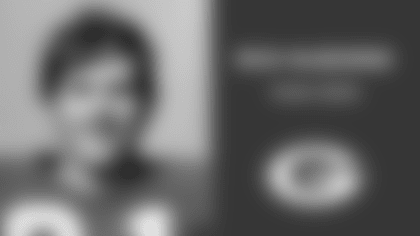Playing what some thought might be his last game as the nickel corner with Al Harris still on the physically unable to perform list, Shields made a spectacular interception in the first quarter on a deep pass to receiver Miles Austin. He was in perfect position inside Austin along the sideline and then reached up and hauled in the ball with his right hand for his first career pick.
"He actually caught it with the wrong hand, but that's just pure talent," cornerbacks coach Joe Whitt Jr. said. "You don't teach that."
You also can't teach speed, and Shields displayed his on the opening second-half kickoff. He took the ball 6 yards deep in the end zone, broke to his right and sprinted out to the Green Bay 43-yard line for a 49-yard return on his first career attempt. The burst and acceleration on display was unlike any seen on a Green Bay kickoff return in recent years.
"A couple of their guys had leverage angles on him, and he just flat outran them," special teams coordinator Shawn Slocum said.
That all contributed to a couple of significant announcements on Monday, when the Packers released Harris – essentially confirming their faith in Shields as the nickel back from here on out – and Head Coach Mike McCarthy declared Shields the team's No. 1 kickoff returner.
It was another couple of big steps in the already impressive rise of a non-drafted player who switched from receiver to cornerback only last year, as a senior at Miami (Fla.), and who struggled to catch the ball cleanly on returns during spring workouts and training camp as a rookie just trying to make the team.
But Shields has earned his roles by doing nothing but improve the more he plays. As a cornerback, Shields was starting as close to ground zero as an NFL player could, having played only one season at the position in college.
Whitt even admitted he never expected Shields to be able to play at this level this soon, having worked with converted receivers in the past. But he proved to be a quick study "just understanding defensive football."
"When we first got him, he didn't understand coverages, just base coverages and base techniques," Whitt said. "He didn't know it. But now he is a defensive back. He's not a receiver playing defensive back."
Shields won the nickel job as the third corner behind starters Charles Woodson and Tramon Williams to start the season, and he experienced the expected ups and downs early on. He helped hold Philadelphia speedsters DeSean Jackson and Jeremy Maclin (a combined 68 yards receiving, with one TD) in check in Week 1 but then allowed a couple of explosive gains to Chicago's Johnny Knox in Week 3.
Shields missed the next two games with a calf injury and then began working his way back to full strength. He caught a break when the Jets' Santonio Holmes dropped a ball on a crossing route on a big third down play in Week 8 but otherwise played his part in the defense's impressive shutout as New York's receiving trio of Holmes, Jerricho Cotchery and Braylon Edwards caught just eight of 23 targeted passes.
His work this past week against the Cowboys was just as solid. He had the acrobatic interception, and even though he did allow a touchdown pass to rookie Dez Bryant on a fade route, Shields was right where he was supposed to be. He just got outjumped by a bigger (Bryant is 6-foot-2, 217 pounds; Shields is 5-11, 184) player.
"I like Sam's demeanor," defensive coordinator Dom Capers said. "He's come in and he's been all business in the meeting rooms. He's tuned in and he's really worked hard to try to improve, and I think he has. You see it on the practice field. That's a tough position to stick a rookie out there."
Shields' reaction after the game to giving up the TD reflected the demeanor Capers is referring to. Shields simply said, "You have to forget about it and move on to the next play," and that approach has served him well. Even though Bryant beat him on the short fade, Capers said the longer one to Austin that Shields picked off will make quarterbacks start to think twice about challenging him in that manner, now that his ball skills on a play like that are on film.
Whitt's approach with Shields has been to focus on one area of improvement each week, whether that's his press coverage, his back pedal, the use of his hands, etc. Whitt said he's still working with him a lot on zone drops and his tackling skills.
"There's areas he can definitely improve and he will improve," Whitt said. "The guy is a conscientious young man. He works hard and he studies film. He wants to be Charles Woodson. He wants to be where those guys are, so that gives him a chance."
Shields also wants to contribute to the return game, and it was frustrating when he didn't really give himself a chance with his shaky hands early on. But Shields kept at it, and with fellow cornerback and returner Pat Lee nursing an ankle injury last week, the Packers kept Shields' regular-season debut as a return man a secret all week long.
"Players change, particularly young players, and Sam has a high upside," Slocum said. "He still does. He's been working on catching the football since the day he got here."
Slocum also sees the relatively new rule on kickoff returns working to Shields' advantage. Beginning in 2009, as a safety measure the NFL outlawed the "wedge" blocking formation on kickoff returns, no longer allowing more than two players to line up shoulder-to-shoulder as blockers.
As teams have adjusted their schemes to fit the new rule over the past season and a half, Slocum believes the pure speed of the return man has become an even bigger asset.
"I think you take a look at it this way – you can line up defensively against a three-back offense, with three-yards-and-a-cloud-of-dust mentality, or a four- or five-wide spread offense and have to defend the whole field," Slocum said. "When they got away from the wedge, it started creating spacing on the field, and you can get short real quickly from a coverage standpoint with so many spaces and open holes.
"The impact of the kickoff returner is getting greater and greater."
Touchdowns aren't the only measure, but interestingly, there have already been 14 kickoffs returned for TDs in the NFL this year through nine weeks, nearly equaling the 18 all of last season. That was up from 13 in 2008, the year before the rule change. But there were also a record 25 kickoffs returned for scores in 2007, so statistically it's still too soon to draw any conclusions on the overall impact of the rule.
With his speed, Shields may be the best chance the Packers have to add to the TD list this year. His 49-yard effort was the longest by a Packers' player on his first career attempt in 29 years, and if he hasn't heard already, he'll keep being reminded that the Packers haven't taken a kickoff the distance in a full decade.
That's just another reason to keep an eye on Shields, whose impact in games may only grow from here, now that he's fully entrenched as the nickel – an alignment Capers uses well over half the time – and has added return duties to his plate.
His baptism by fire continues.
"Sam has done everything we've asked him to do," Whitt said. "His best football is in front of him, and by no means is he there. But he's going to be a good football player, and the thing is he has to do it now. I think he's done everything to deserve to be on the field right now. He's earned it."















